If you are looking for a big, colorful fish with a distinct personality for your saltwater tank, you should definitely give triggerfish species a chance.
Whether you’re a beginner or an expert fishkeeper, there’s a fascinating species for all hobbyists.
These also come in various sizes, making them an excellent pick for aquatic havens of all ranges!
Intrigued to know more? Let us learn in detail about the different mesmerizing fishes in this family.
What is a Triggerfish?
Triggerfish, belonging to the Balistidae family and Tetraodontiformes order, boast around 40 species in tropical and subtropical oceans globally. They prefer shallow, coastal waters, especially coral reefs.
These have a unique triggering mechanism that gives them their family name. The first two dorsal spines of these fish get erected to protect themselves from predators.
The first spine locks in place when the shorter second spine is erected, unlocking only when the trigger spine is depressed.
These fish have highly compressed bodies, small mouths, and sharp teeth suited for crushing shells. The aggressive species prey on crustaceans, mollusks, and algae in the ocean.
Triggerfish also exhibit intriguing behaviors, like utilizing water jets to dig prey from crevices. It also displays remarkable intelligence, often learnt from experiences.
Both male and female triggerfish contribute significantly to their reproductive cycle. Males establish territories, build nests, and mate with visiting females, displaying fascinating mating rituals.
Many triggerfish species follow interesting lunar and tidal patterns for spawning. Eggs are laid 2-6 days before a full moon and 3-5 days before a new moon.
Spawning often happens 1-5 days prior to a spring tide near sunset, reducing tidal current for better egg development. This makes breeding them in the home aquarium a rewarding endeavor!
What are the Types of Triggerfish?
1. Clown Triggerfish (Balistoides conspicillum)
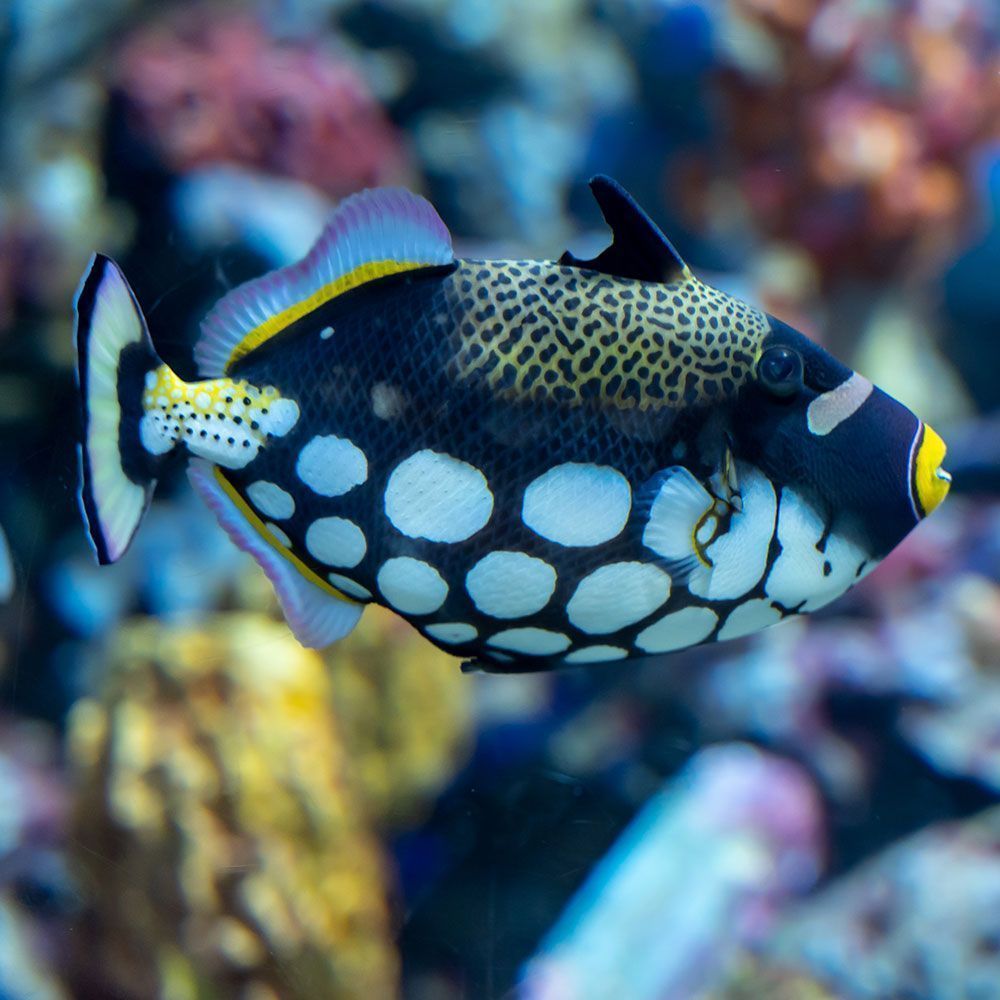
- Other Common Names: Big spotted triggerfish
- Average Size: Usually, up to 33 cm (13 in), Max: 50 cm (19.7 in )
- Average Lifespan: Up to 8 years in the wild, Max: 20 years in captivity
- Tank Level: Bottom dweller
- Temperament: Highly aggressive and territorial
- Diet: Carnivorous, predators
- Reef Safe: No
- Tank Mates: Aggressive, large fish
- Minimum Tank Size: 225 gallons
Clown triggerfish have a clown-like appearance with a black, stocky, oval-shaped body, large head, small terminal white-ringed mouth, strong teeth, and asymmetrical white spots on the bottom half.
Its top half, from the pectorals to the dorsal fin, is yellow with black spots. There’s a distinctive yellow snout stripe. It can move each eye independently.
Juvenile fish is black with white spots that fade as it matures. Its snout and first dorsal fin base are yellowish.
Clown triggerfish are known for rearranging rocks, corals, and tank decorations. To prevent damage and ensure safety, it’s essential to securely fasten tank contents.
2. Niger Triggerfish (Odonus niger)
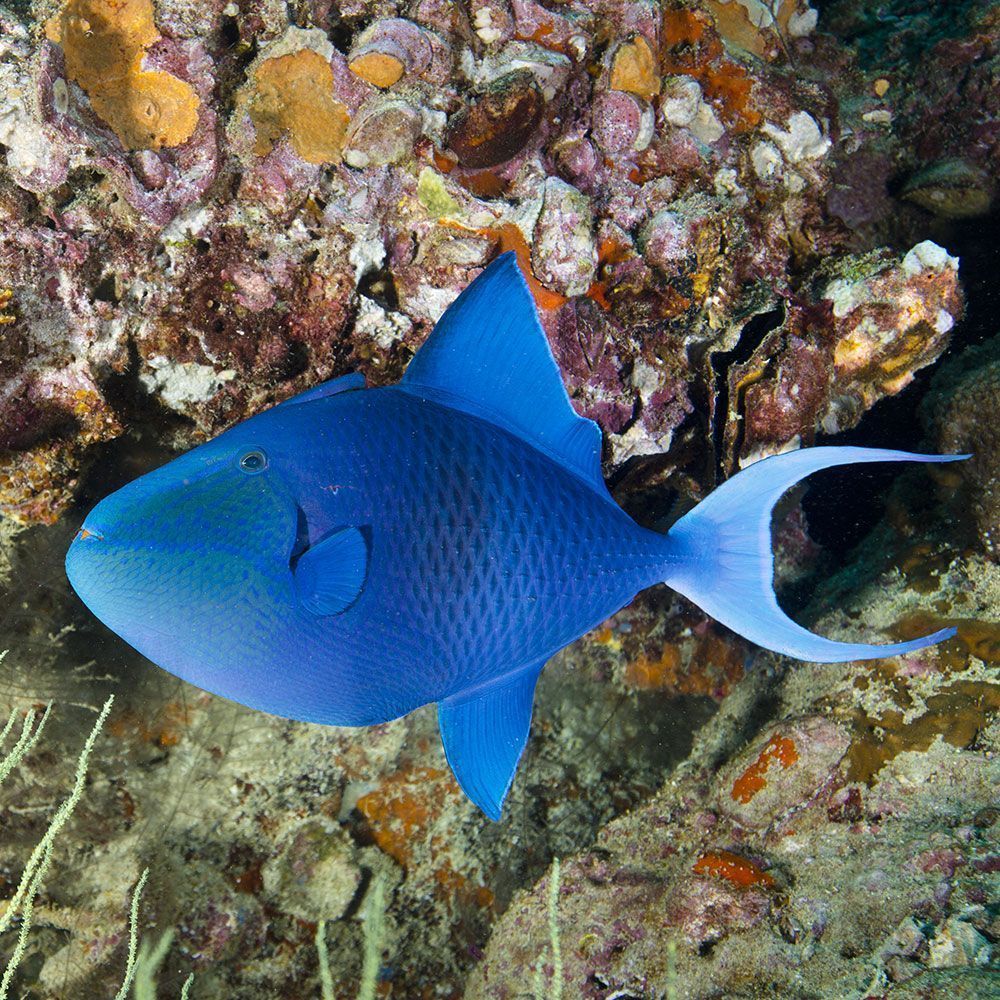
- Other Common Names: Redtoothed triggerfish, blue triggerfish, redfang triggerfish, redtoothed niger triggerfish, redtoothed filefish
- Size: Usually 30 cm (11.8 in) Max: 50 cm (19.7 in)
- Lifespan: Up to 10 years
- Tank Level: Bottom-dwellers
- Temperament: Aggressive and territorial
- Diet: Carnivorous
- Reef Safe: No
- Tank Mates: Large fish with boisterous and aggressive tendencies
- Minimum Tank Size: 180 gallons
The niger triggerfish typically boasts a deep purple hue with bluish-green markings on its head. Its eye and anal fin are outlined in light blue, creating a captivating effect.
The mouth appears to be grinning, revealing sharp, needle-like red teeth. It also has a lyre-shaped tail and lacks pelvic fins.
Adult fish can change color based on mood, diet, and water quality, shifting from purple to blue and bluish-green. When excited, it emits a distinctive grunting sound.
Juveniles have a dark blue or green shade. Notably, not all young fish develop red teeth.
The niger triggerfish boasts a unique swimming style in the ocean. With small pectoral fins, it relies on dorsal and anal fins for steering, displaying remarkable maneuverability. The exotic propulsion method resembles a propeller, making it stand out among marine swimmers.
3. Queen Triggerfish (Balistes vetula)
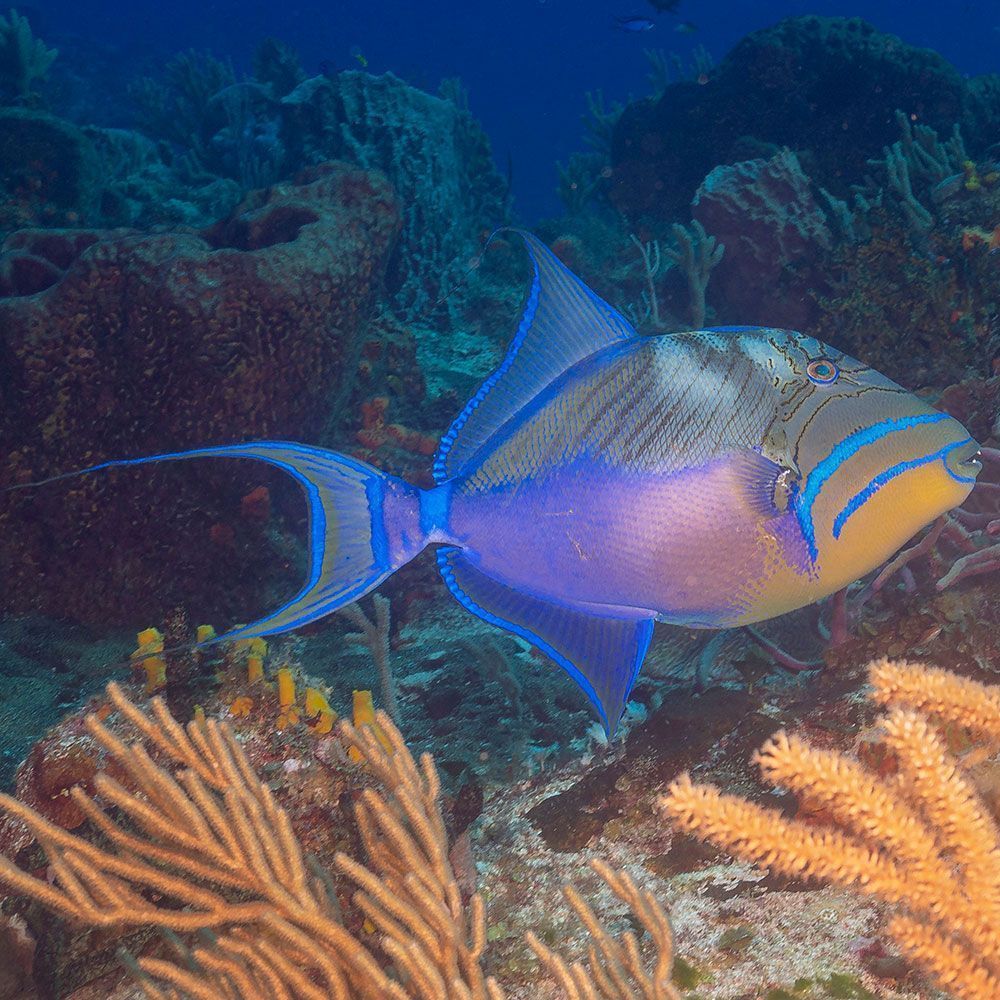
- Other Common Names: Old wife, ol’wife, turbot
- Average Size: Usually up to 30 cm (11.8 in), Max: 60 cm (24 in)
- Lifespan: Around 7-13 years
- Tank Level: All levels
- Temperament: Aggressive
- Diet: Carnivorous
- Reef Safe: No
- Tank Mates: Larger aggressive or semi-aggressive species
- Minimum Tank Size: 500 Gallons
The queen triggerfish is triangle-shaped with typically blue, purple, bluish-gray, turquoise, or green on the back with an orange or yellow coloration on the head and belly.
It also has two wide blue bands that curve from the snout to the front of the side fins. The lower band connects to a blue ring around the lips. Additionally, it has a broad blue line near the tail and blue edges on the side fins.
Juvenile fish aren’t as colorful. It’s greyish brown, with blue oblique lines across the lower head and dashed oblique black lines on the body. Furthermore, it has smaller fins that become flowy as it grows.
Interestingly, its teeth keep growing, so it needs rocks, sponges, and the right food to wear them down. Otherwise, the teeth might painfully overgrow.
Male and female queen triggerfish look alike, but the males are bigger and have longer tail parts. During the spawning season, males become even more colorful.
It’s important to check if the fish is fully grown before trying to tell its gender, or you might mistake young males for females.
Being a skilled predator, the queen triggerfish employs a fascinating technique to catch sea urchins. It creates water movements with its powerful fins that are strong enough to flip over sea urchins, revealing their vulnerable undersides and then it swiftly attacks them.
4. Reef Triggerfish (Rhinecanthus rectangulus)

- Other Common Names: Rectangular triggerfish, wedgetail triggerfish, black-banded triggerfish, rectangle triggerfish, saddle-shoe fish, wedge picasso fish, white-barred triggerfish
- Average Size: Usually 25 cm (9.8 in), Max: 30 cm (11.8 in).
- Lifespan: Up to 5-10 years
- Tank Level: Middle to bottom
- Temperament: Highly territorial and aggressive
- Diet: Carnivore
- Reef Safe: No
- Tank Mates: Larger, more aggressive fish
- Minimum Tank Size: 125 gallons
The reef triggerfish has an angular body and a snout reminiscent of a pig’s nose. It displays a stunning blend of colors, including white, red, blue, black, brown, and yellow.
Its upper body features shades of brown, while a bold black stripe extends from its eye to the base of the anal fin. The base of its pectoral fin is a vibrant reddish-orange.
The teeth and top lip are vivid blue. It has a wedge-shaped black mark extending from the posterior body side onto the caudal peduncle, which gives it the name “wedge-tail.”
Juveniles sport a similar pattern with additional yellow marks. The reef triggerfish skillfully uncovers hidden prey by blowing water jets and sifting through sand to find food.
The reef triggerfish is Hawaii’s state fish, known by its lengthy Hawaiian name, ”Humuhumunukunukuāpuaʻa,” which translates to “triggerfish with a pig-like short snout.” It was part of the famous 1933 song My Little Grass Shack in Kealakekua, Hawaii’s chorus and later appeared in the film High School Musical 2.
5. Titan Triggerfish (Balistoides viridescens)

- Other Common Names: Giant triggerfish, moustache triggerfish, black-lipped triggerfish, bluefin triggerfish, blue-finned triggerfish, dotty triggerfish
- Size: Up to 75 cm (29.5 in)
- Lifespan: Around 7-9 years
- Tank Level: Middle to bottom
- Temperament: Aggressive and territorial
- Diet: Carnivorous
- Reef Safe: No
- Tank Mates: Own species only, or larger aggressive fishes in tanks as large as 1000 gallons
- Minimum Tank Size: 600 gallon
This colorful fish has a laterally compressed body and a small mouth with sharp, chisel-like teeth that keep growing.
Its body has a latticework pattern and is light gray with darker gray, green, and yellow patches, and its fins have black edges.
The titan triggerfish has a unique pattern on its face, like a mustache. It has a bumpy head and body covered in tough scales which have dark centers.
Around its eyes and pectoral fin base, it sports a deep groove and a black area with yellow spots. Its back and bottom fins also have black edges.
The titan triggerfish is a skilled hunter dining on sea urchins, mollusks, crustaceans, tube worms, and coral. Often, while eating, it spreads smaller pieces of food and smaller fish gather to feed on the detritus.
6. Picasso Triggerfish (Rhinecanthus aculeatus)

- Other Common Names: Lagoon triggerfish, blackbar triggerfish, picasso fish, lagoon humu, painted trigger, humu Picasso triggerfish, humuhumu triggerfish, whitebanded triggerfish, prickly triggerfish
- Size: Up to 30 cm (11.8 in)
- Average Lifespan: Around8-10 years
- Tank Level: All levels, primarily bottom-dwelling
- Temperament: Highly territorial and aggressive
- Diet: Carnivore
- Reef Safe: No
- Tank Mates: Aggressive tank mates of similar size
- Minimum Tank Size: 500 gallons
Its appearance is so colorful and distinctive that it’s named after the famous painter Pablo Picasso.
The triangle-shaped fish has bright colorful bands. Its mouth is yellow, resembling lipstick from its lips to its cheeks.
There’s a yellow stripe from its mouth to just below its side fins. Its mouth is encircled by a bright blue ring.
On the top of its head, there are bold blue and dark black stripes that meet the yellow stripe near the side fin. Four white stripes cross over a black patch from its back fin to its middle.
There’s even a slanted rusty-black band from its upper back fin forward to its middle. This unique fish also has small black spines on its sides near its tail. It is difficult to distinguish between the male and female fish.
This fish is like an underwater acrobat! It glides through the water using its dorsal and anal fins, making precise movements. With these techniques, it can go forward, backward, or just stay still above the reef. This skill helps it easily maneuver, even backing out of tight spots, which most other unidirectional fish fail to do.
7. Black Triggerfish (Melichthys niger)
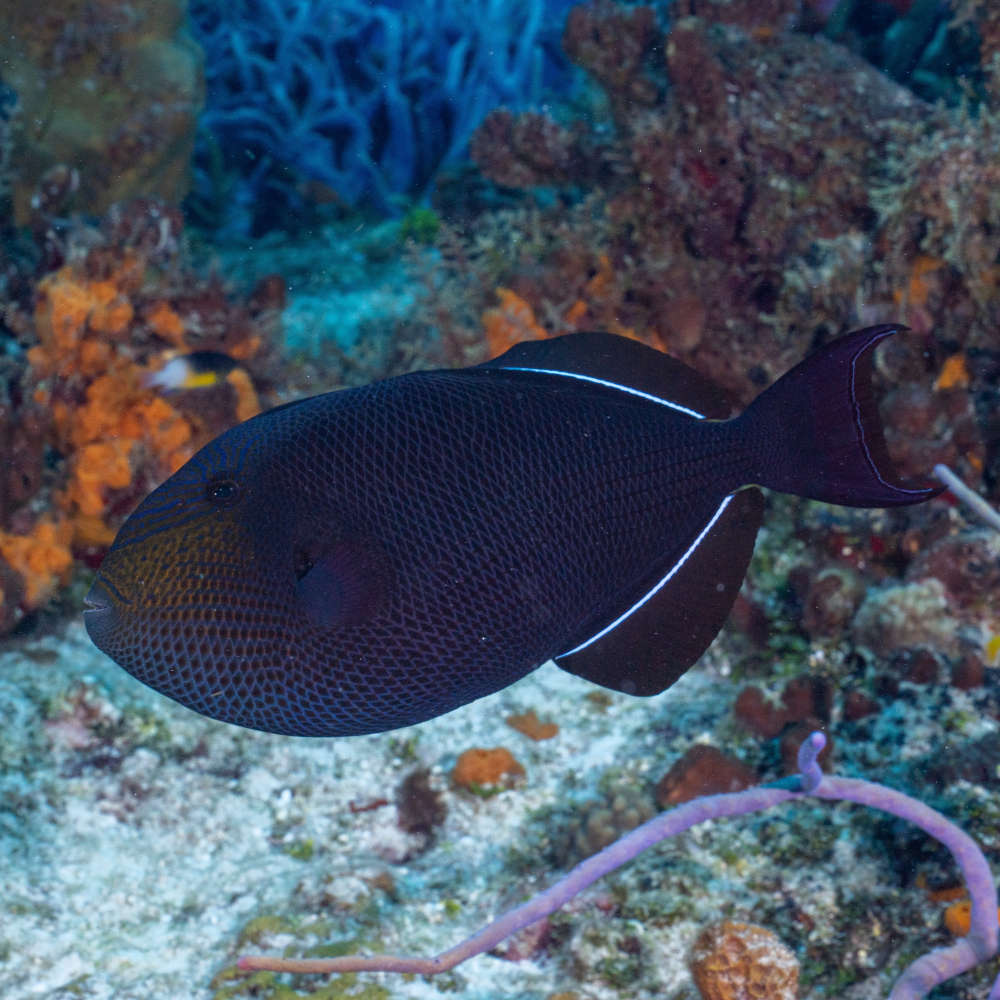
- Other Common Names: Black durgon, pigger, niggerfish, niger head
- Size: Usually up to 30 cm (12 in); Max: 45 cm (18 in)
- Lifespan: Around 5-6 years
- Tank Level: All levels
- Temperament: Highly aggressive and territorial
- Diet: Omnivorous
- Reef Safe: No
- Tank Mates: Larger or same-sized aggressive to semi-aggressive species
- Minimum Tank Size: 125 gallons
The black triggerfish, with a blimp-shaped body, looks black from far away. But up close, it’s actually a mix of mottled dark blue and green, sometimes with hints of orange near its face.
It has white lines running along its dorsal and anal fins and can change color to match its surroundings.
The Hawaii species has a black body, orange face, and interesting patterns. Unlike the Indian Ocean species, it’s more colorful, with different shades of blue and green that change every day. The head is lighter in color and the tail has long fringes on the top and bottom edges.
Unlike most fish, they primarily use their anal and dorsal fins to glide gracefully through the water. But when they need to dart, their tails move rapidly, creating a swimming style unlike any other species.
8. Grey Triggerfish (Balistes capriscus)

- Other Common Names: Turbot, pig-faced, cucuyo, common triggerfish, filefish, leatherjacket
- Average Size: Commonly 44 cm (17.3 in), Max: 60 cm (23.6 in).
- Average Lifespan: 15 years
- Tank Level: Bottom dweller
- Temperament: Aggressive and territorial
- Diet: Carnivorous
- Reef Safe: No
- Tank Mates: Similar-sized or larger aggressive or semi-aggressive fish
- Minimum Tank Size: 200 gallons or larger
The young grey triggerfish is primarily grayish-green, with three darker vertical bands on its sides and an additional band under its chin.
There might be small blue spots and lines on its dorsal fins and upper body. Sometimes, it has white dots and irregular lines on its lower parts.
It has a small beak-like mouth at the tip of its snout, with fleshy lips and rounded pectoral fins. Both the second dorsal and anal fins exhibit a marbled appearance.
As it matures, the fish becomes predominantly gray in color, but the bars remain, and the outer rays of the caudal fin elongate. The eyes, positioned near the top of its head, have a blue upper orbit and are set far back.
9. Pinktail Triggerfish (Melichthys vidua)
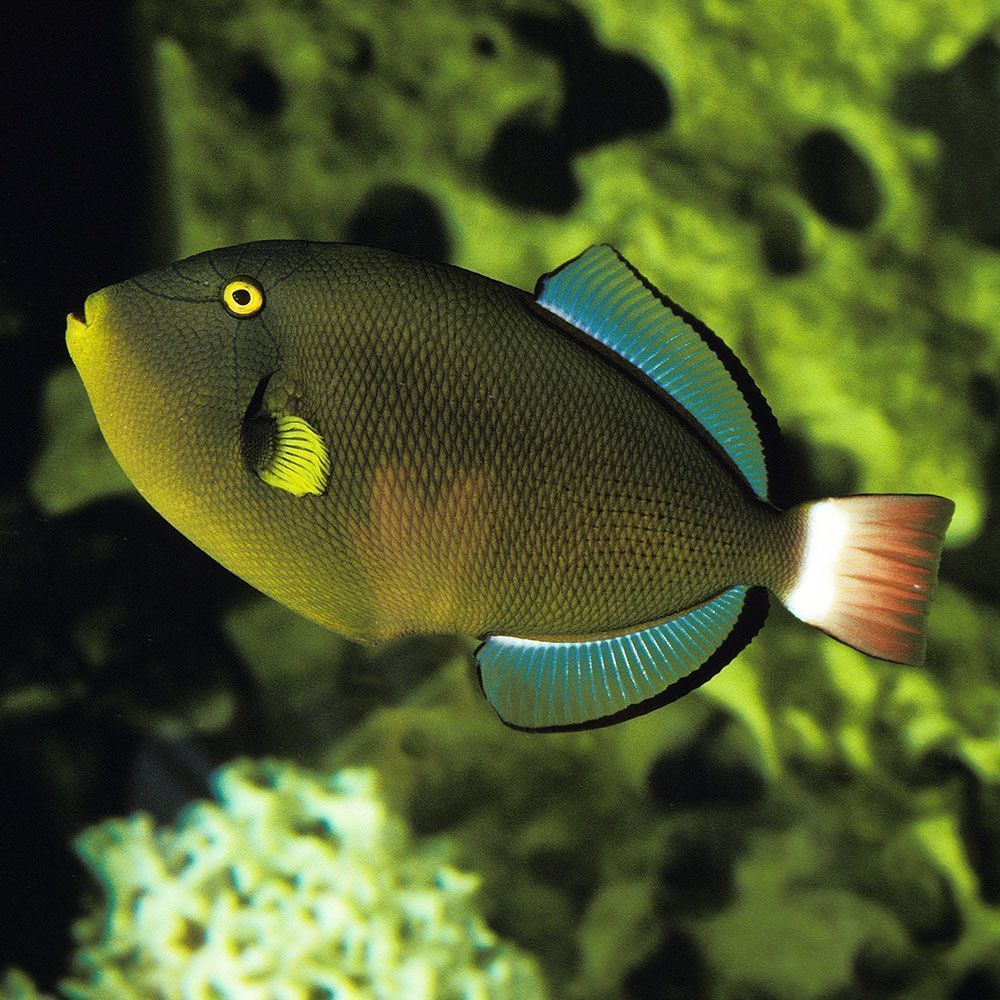
- Other Common Names: Red-tailed triggerfish, pink-tail durgon, pink-tail trigger, paddle-fin triggerfish, leatherjacket
- Size: Up to 40 cm (15.7 in)
- Average Lifespan: Over 10 years
- Tank Level: All level
- Temperament: Mildly aggressive, interactive
- Diet: Carnivorous
- Reef Safe: Safe, with caution- eats crustaceans and small fish
- Tank Mates: Similar-sized or larger aggressive or semi-aggressive fish
- Minimum Tank Size: 180 gallons tank
The pinktail triggerfish has a dark green, appearing almost black body, with delicate, translucent, pinkish-white dorsal and tail fins, earning its name. These fins are adorned with dark bands at the outer edges.
Yellow accents adorn its face and pectoral fins, with tiny dark flecks on the scales. It’s hard to tell males and females apart.
10. Crosshatch Triggerfish (Xanthichthys mento)
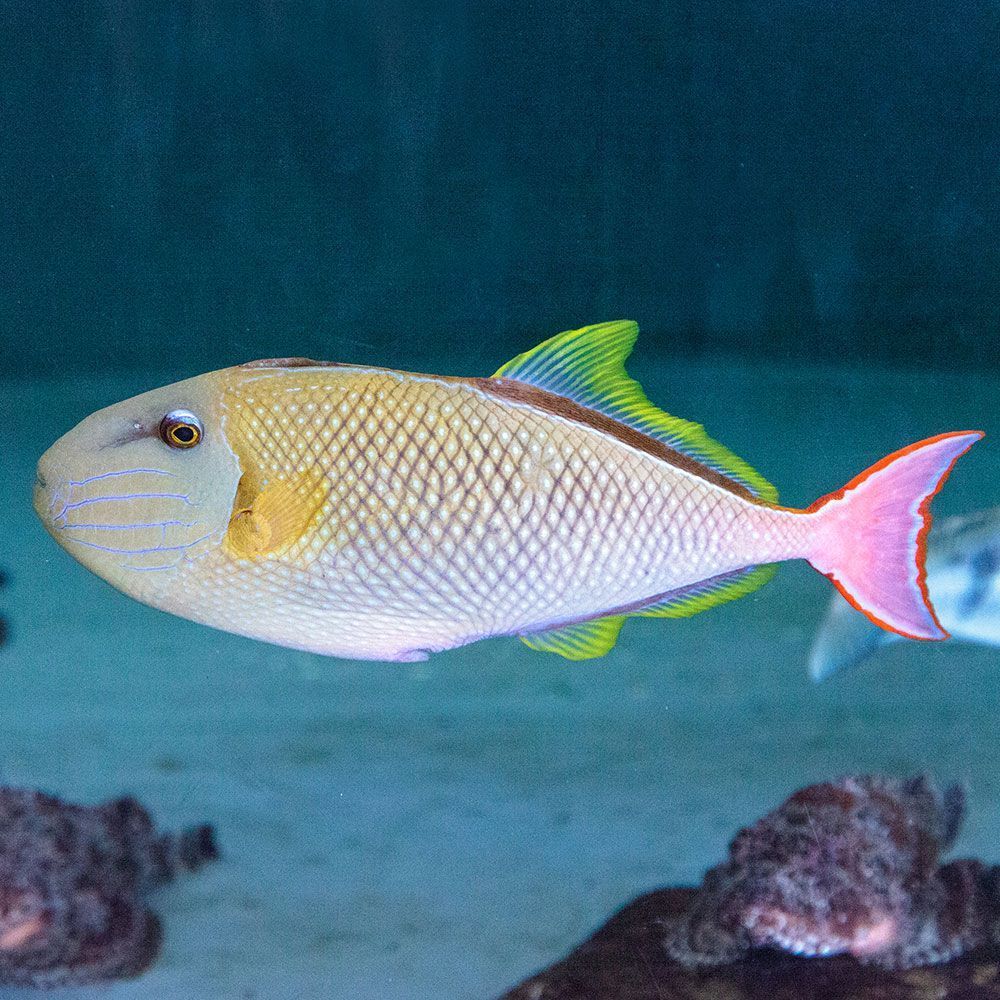
- Other Common Names: Redtail triggerfish, blue-throat triggerfish, crosshatch triggerfish, peach face triggerfish, blue cheek line triggerfish
- Size: Up to 30 cm (11.8 in)
- Average Lifespan: Around 10-15 years
- Tank Level: Mid-water and bottom dwellers
- Temperament: Aggressive
- Diet: Carnivorous
- Reef Safe: Yes, but with caution
- Tank Mates: Aggressive towards triggers but ignores all other inhabitants
- Minimum Tank Size: 225 gallons for 1
Crosshatch boasts the classic triangular shape common among triggerfish, especially when its fins are upright. When in motion, it resembles a streamlined torpedo.
Males exhibit vibrant yellow bodies and striking red-rimmed tails. In contrast, females have a more subdued greyish coloration with yellow-fringed caudal fins.
Both genders feature distinctive blue radiating lines on their faces and crisscrossing black lines along their leather-like skin with heavy scales, which inspired their name “crosshatch.”
Notable features include a distinct groove before the eye and below the nostril, along with a small mouth that opens slightly above the body’s center line.
A word from FishInAquarium
Owing to the resilient and fierce nature of triggerfish, it can be a delightful experience to raise them.
Not only can these fish be head-turning pieces for your tank, but they also thrive in various conditions. Their hearty appetite also makes mealtime so much more exciting!
If you enjoyed reading about the fascinating world of triggerfish, please consider sharing it with aquarist friends. Feel free to reach out via email if you have any questions or need further support.


